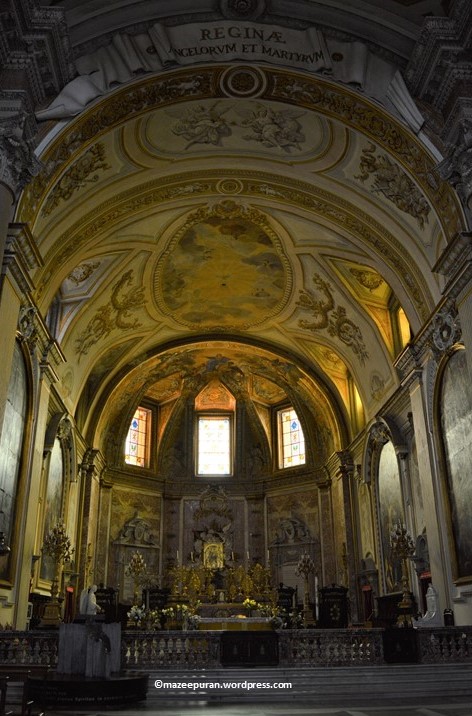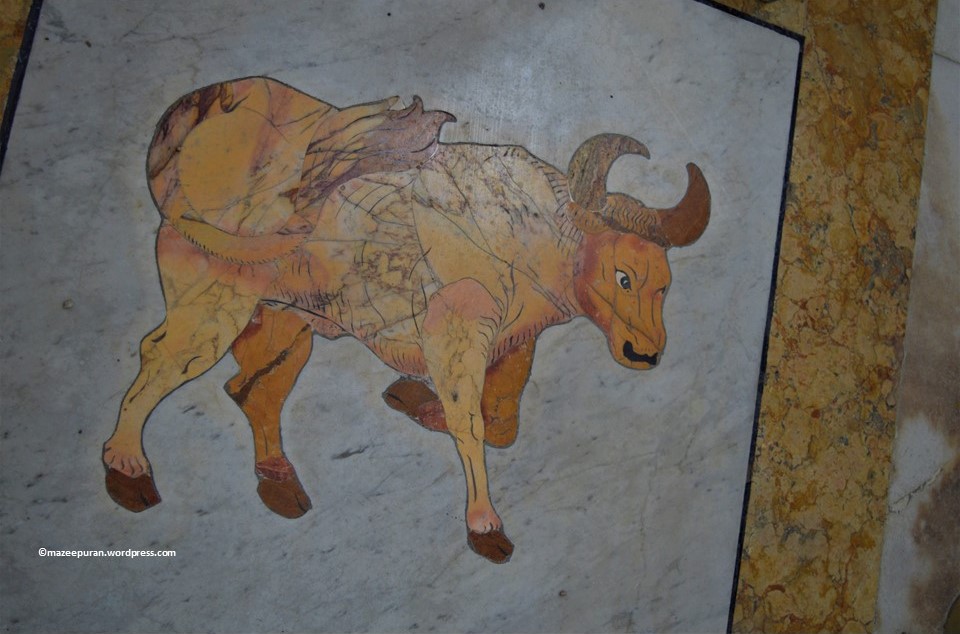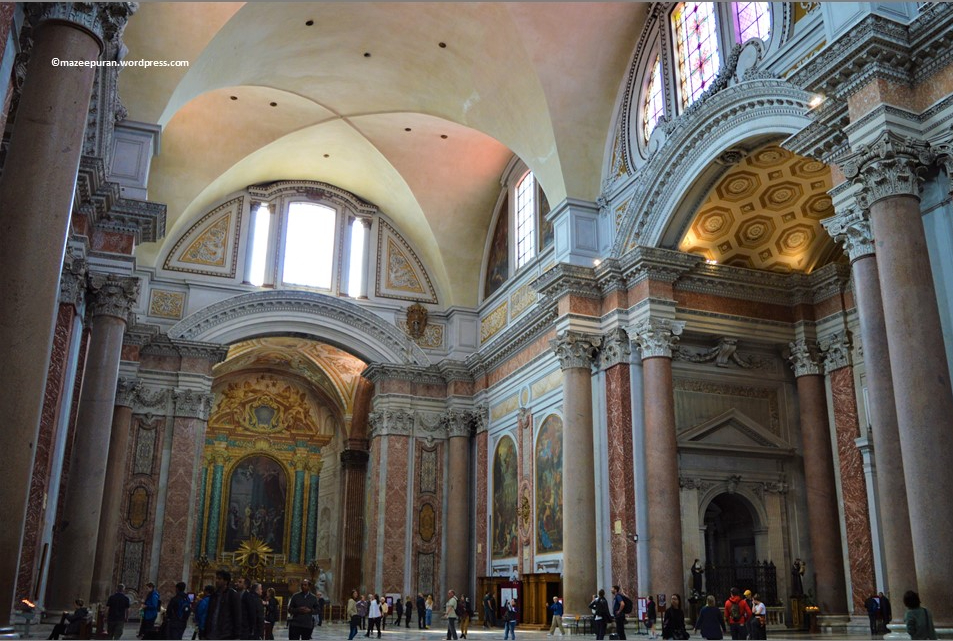
The Basilica of St. Mary of the Angels and the Martyrs was constructed in the 16th century following an original design by Michelangelo Buonarroti.

At the beginning of the 18th century, Pope Clement XI commissioned the astronomer, mathematician, archaeologist, historian and philosopher Francesco Bianchini to build a meridian line, a sort of sundial, within the basilica.
There is hole in the church’s wall from which the sun can shine through and onto the meridian line.

Tthe object had a threefold purpose: the pope wanted to check the accuracy of the Gregorian reformation of the calendar, to produce a tool to predict Easter exactly, and, not least, to give Rome a meridian line as important as the one Giovanni Domenico Cassini had recently built in Bologna’s cathedral, San Petronio. Alan Cook remarked, “The disposition, the stability and the precision are much better than those of the famous meridian… in Bologna”.
Bianchini’s sundial was built along the meridian that crosses Rome, at longitude 12° 30′ E. At solar noon, which varies according to the equation of time from around 10:54 a.m. UTC in late October to 11.24 a.m. UTC in February (11:54 to 12:24 CET), the sun shines through a small hole in the wall to cast its light on this line each day. At the summer solstice, the sun appears highest, and its ray hits the meridian line at the point closest to the wall. At the winter solstice, the ray crosses the line at the point furthest from the wall. At either equinox, the sun touches the line between these two extremes. The longer the meridian line, the more accurately the observer can calculate the length of the year. The meridian line built here is 45 meters long and is composed of bronze, enclosed in yellow-white marble.

In addition to using the line to measure the sun’s meridian crossing, Bianchini also used the window behind the pope’s coat of arms and a movable telescope to observe the passage of several stars such as Arcturus and Sirius to determine their right ascensions and declinations. The meridian line was restored in 2002 for the tricentenary of its construction, and it is still operational today.



References:
https://en.wikipedia.org/wiki/Santa_Maria_degli_Angeli_e_dei_Martiri
http://www.jgiesen.de/meridian/rome/
https://ar-tour.com/guides/rome-day-1/santa-maria-degli-angeli-e-dei-martiri.aspx
Geometry used to spectacular effect.
LikeLiked by 2 people
Oh yes. I was about to get lost. Thanks Laurie.
LikeLiked by 2 people
Amazing! I knew the Italians were masters of arches, especially in their churches but whole meridian concept was new to me. A really interesting approach to the challenge Rupali
LikeLiked by 2 people
And to me. Thanks Tina.
LikeLiked by 2 people
You captured much geometry … and an Italian church is a great place to do it.
LikeLiked by 2 people
Thanks Frank.
LikeLiked by 2 people
Wow i learned something new today..
LikeLiked by 2 people
I am glad Mich 🙏
LikeLiked by 2 people
Geometry and more! Nice response to the challenge.
LikeLiked by 2 people
Thanks Anne.
LikeLiked by 1 person
Amazing pictures of Roman art and architecture! I enjoyed reading, learning the new information 🙂
LikeLiked by 2 people
It’s fascinating. Thanks Pragalbha.
LikeLiked by 2 people
Rome could never be boring, no? Beautiful churches, historic paintings and designs of Great Masters. Well recorded and photographed post dear Rupali. Thank you. Brought back memories of 1966.
LikeLiked by 2 people
Thank you so much dear Zakiahji. I was a newbie photographer and had not done my homework quite well before visiting Rome. I have missed a lot. I see a reason to visit it again.
LikeLiked by 2 people
Me too. I would love to visit Rome again. Been to other parts of Italy a few times along the Italian Riviera, but Rome was a stop over on my way here after our wedding, and we did the touristy things in the two or three days we stayed there.
LikeLiked by 2 people
I am sure Rome has changed a lot during these years 😀
LikeLiked by 2 people
beautiful photographs, Rupali. the churches in Rome are rich both in beauty and history. 🙂
LikeLiked by 2 people
Aren’t they Wilma. Thanks a lot.
LikeLiked by 2 people
Beautiful arches and ceilings, so well captured. And the reading was really interesting.
LikeLiked by 2 people
Thanks Deb. I need to visit Rome again. I see now how much I have missed.
LikeLiked by 1 person
Interesting. Some calculations are so important. Humans has such a brilliant mind.
LikeLiked by 2 people
Right. Thanks.
LikeLiked by 2 people
Quite fascinating
LikeLiked by 2 people
Yes indeed. Thanks Derrick.
LikeLiked by 2 people
The architecture looks wonderful.
LikeLiked by 2 people
Thanks Kritika.
LikeLiked by 2 people
Welcome 🙂
LikeLiked by 2 people
Amazing pics and related information.
LikeLiked by 2 people
Thanks Kaushalji.
LikeLiked by 2 people
Beautiful photos and fascinating historical info, Rupali.
LikeLiked by 3 people
Thanks Amy.
LikeLiked by 1 person
This is a beautiful piece of history Rupali and brilliant geometric patterns in Santa Maria Church. Great 👍🏼👍🏼👍🏼
LikeLiked by 3 people
Thanks kindly dear Kamal.
LikeLiked by 1 person
Always welcome dear Rupali 💖💘💘
LikeLiked by 2 people
Beautiful photos, informative commentary. Well done.
LikeLiked by 3 people
Thanks John.
LikeLiked by 1 person
One day I’ll make it to Rome! 🙂 🙂
LikeLiked by 2 people
You have given a wonderful post for the prompt
LikeLiked by 3 people
Thanks Subbashini.
LikeLiked by 1 person
Great information Rupali. Also great images.
LikeLiked by 3 people
Thanks a lot Anne.
LikeLiked by 2 people